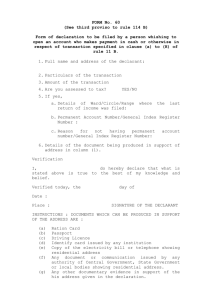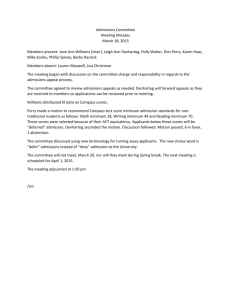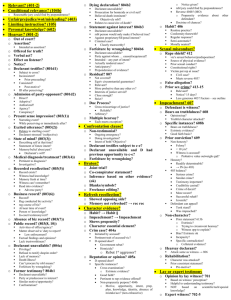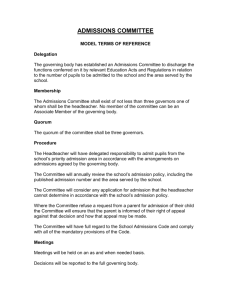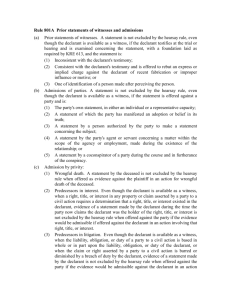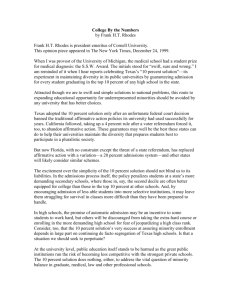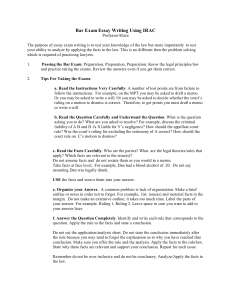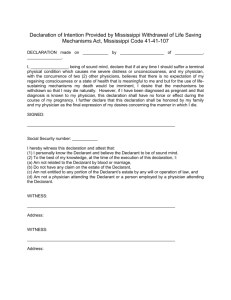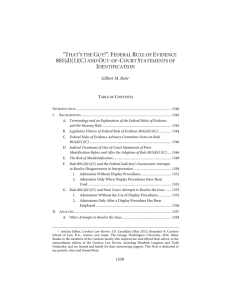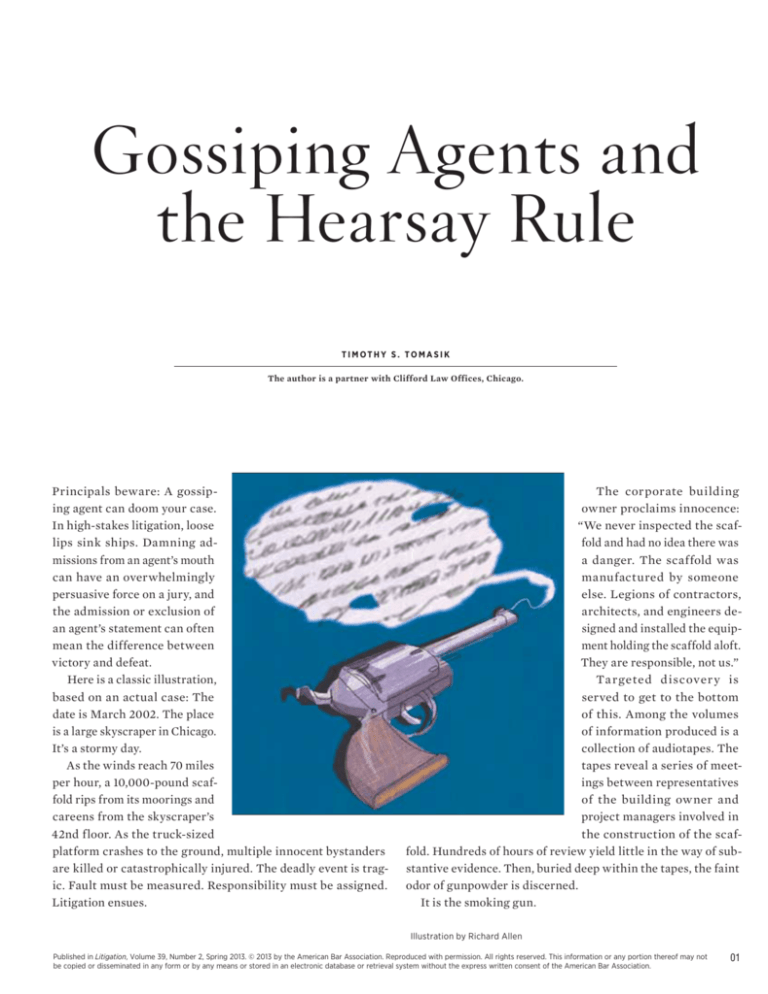
Gossiping Agents and
the Hearsay Rule
Timothy S. Tomasik
The author is a partner with Clifford Law Offices, Chicago.
Principals beware: A gossiping agent can doom your case.
In high-stakes litigation, loose
lips sink ships. Damning admissions from an agent’s mouth
can have an overwhelmingly
persuasive force on a jury, and
the admission or exclusion of
an agent’s statement can often
mean the difference between
victory and defeat.
Here is a classic illustration,
based on an actual case: The
date is March 2002. The place
is a large skyscraper in Chicago.
It’s a stormy day.
As the winds reach 70 miles
per hour, a 10,000-pound scaffold rips from its moorings and
careens from the skyscraper’s
42nd floor. As the truck-sized
platform crashes to the ground, multiple innocent bystanders
are killed or catastrophically injured. The deadly event is tragic. Fault must be measured. Responsibility must be assigned.
Litigation ensues.
The corporate building
owner proclaims innocence:
“We never inspected the scaffold and had no idea there was
a danger. The scaffold was
manufactured by someone
else. Legions of contractors,
architects, and engineers designed and installed the equipment holding the scaffold aloft.
They are responsible, not us.”
Ta rgeted discover y is
served to get to the bottom
of this. Among the volumes
of information produced is a
collection of audiotapes. The
tapes reveal a series of meetings between representatives
of the building owner and
project managers involved in
the construction of the scaffold. Hundreds of hours of review yield little in the way of substantive evidence. Then, buried deep within the tapes, the faint
odor of gunpowder is discerned.
It is the smoking gun.
Illustration by Richard Allen
Published in Litigation, Volume 39, Number 2, Spring 2013. © 2013 by the American Bar Association. Reproduced with permission. All rights reserved. This information or any portion thereof may not
be copied or disseminated in any form or by any means or stored in an electronic database or retrieval system without the express written consent of the American Bar Association.
01
Just a few months before the collapse, representatives of
the owner met with the project architect and others—one of
many meetings caught on tape. The project architect made a
simple request for updated engineering specifications for the
roof equipment supporting the scaffolding. The ensuing dialogue is remarkable:
Project Manager (Owner): “When they take it down off the
building, you’ll get them.”
Construction Manager (Owner): “It’s like building a Pinto.”
Project Manager: “It’s like building what?”
Construction Manager: “Pinto.”
Architect: “I’m almost afraid to ask what he means by that.”
Project Manager: “Put the gas tank in first and worry about
it later.”
Construction Manager: “It’s only a $50 part.”
Architect: “Oh, my goodness!”
Yes, dreams can come true in discovery. Months before a
deadly incident, a gossiping agent is caught on tape referring
to the instrumentality of death as a “Pinto.” Now the critical
question: Can the admission be used at trial?
Successfully capturing these statements for admission at trial
requires lawyers to master Federal Rule of Evidence 801(d)(2)
(D), which governs admissibility of an agent’s admission. By the
same measure, strategically navigating and implementing Rule
801(d)(2)(D) is critical when opposing the admissions of partyopponent agents. Understanding the striking differences in the
application of the rule in common-law jurisdictions and in federal courts is paramount to your success—whether you are on the
offense or defense. Rule 801(d)(2)(D) provides that a statement
is not hearsay if “the statement is offered against an opposing
party and was made by the party’s agent or employee on a matter within the scope of that relationship and while it existed.”
A New Consensus
Courts have now come to a virtual consensus that Rule 801(d)
(2)(D) does not require personal knowledge or the authority
to speak on behalf of the principal. Not so simple in commonlaw jurisdictions. Long ago, many of us were instructed in law
school that it was impermissible under common law for a jury to
hear a damaging admission of an employee who had no personal
knowledge of the facts giving rise to liability or who was not
authorized to speak on behalf of the employer. Courts reasoned
that it was unfair to bind the principal by statements of dubious
reliability—watercooler gossip, for example.
The majority of courts applying the common-law rule found
damaging statements to be outside the scope of authority, even in
cases involving relatively high-level executives, because employees are seldom hired to make damaging statements. Application
of the common-law rule often resulted in dispositive motions being granted and relevant and valuable evidence being barred.
Courts recognized that the common-law approach imposed an
impossible burden on proponents because, as a practical matter, courts could not envision a set of facts where an employee
was specifically authorized to make a statement detrimental
to the employer’s interest. Pavlik v. Wal-Mart Stores, Inc., 323
Ill. App. 3d 1060 (2001).
Courts have increasingly held that such a concern is misconceived when it comes to party statements. Unlike the other rules
of evidence, the rules on admissions are not based on reliability
and do not require personal knowledge. Rather, admissions are
a by-product of our adversarial system of justice. 4 Steven A.
Saltzburg et al., Federal Rules of Evidence Manual § 801.02[6]
[f ][i] (Matthew Bender 10th ed.). Dissatisfaction with unjust
outcomes led courts to abandon the old principles governing
the admission of employee statements in favor of new ones that
promoted the generous treatment of admissions.
Courts are now in general agreement that the rule does not
mandate personal knowledge—that “no guarantee of trustworthiness is required in a case of an [agent] admissions.” Fed. R.
Evid. 801(d)(2)(D) advisory committee’s note. Despite the modern recognition of this rationale by courts applying both the federal rule and the common-law rule, many remain unaware that
the old common-law principles that once applied have essentially
been abandoned. In motion and trial practice, many opponents
remain steadfastly wedded to recycling old arguments asserting that such statements are inadmissible because the defendant
lacked sufficient personal knowledge or was unauthorized by
the principal to speak on the principal’s behalf. Mister v. Ne. Ill.
Commuter R.R. Corp., 571 F.3d 696 (7th Cir. 2009).
It is essential that trial lawyers be well equipped to overcome these misguided objections to ensure that all relevant
statements are considered by the jury. Most often, the objection is premised on the tension in the Federal Rules of Evidence
between the personal knowledge requirement of Rule 602 and
its effect on the admissibility of party-opponent admissions
under Rule 801(d)(2)(D). When attacking the admissibility of
statements, opponents often claim the agent lacks sufficient
knowledge, citing Rule 602, which provides that “[a] witness
may testify to a matter only if evidence is introduced sufficient
to support a finding that the witness has personal knowledge
of the matter.”
On its face, the personal knowledge requirement of Rule 602
seemingly collides with Rule 801(d)(2)(D), which states that a
statement is not hearsay if “[the] statement is offered against an
opposing party and was made by the party’s agent or employee
on a matter within the scope of that relationship and while it
existed.” The advisory committee’s notes emphasize the rationale behind this more liberalized approach to admissibility:
Published in Litigation, Volume 39, Number 2, Spring 2013. © 2013 by the American Bar Association. Reproduced with permission. All rights reserved. This information or any portion thereof may not
be copied or disseminated in any form or by any means or stored in an electronic database or retrieval system without the express written consent of the American Bar Association.
02
[T]he freedom which admissions have enjoyed from technical
demands of searching for an assurance of trustworthiness in
“statement against interest” circumstances, and from the restrictive influences of the opinion rule and the rule requiring
firsthand knowledge, when taken with the apparently prevalent satisfaction with the results, calls for generous treatment
of this avenue of admissibility.
Fed. R. Evid. 801 advisory committee’s note.
Common-Law and Modern Applications
To prevail in advocating or opposing the admission of such statements, it is incumbent on trial lawyers to understand the distinction between the common-law and modern applications of
the rule. Courts generally have applied the “traditional agency
approach” or “the scope of employment” approach in determining whether a statement by an agent or employee constitutes
an admission by his or her principal or employer. Pavlik, 323 Ill.
App. 3d at 1060. Under the traditional common-law agency approach, the proponent of the statement must establish that the
declarant was an agent or employee, the statement was made
about a matter over which the declarant had actual or apparent authority, and the declarant spoke by virtue of authority as
such agent or employee.
Common sense dictates that few principals engage agents for
the purpose of making damaging statements. Historically, the
usual result was the exclusion of the statement. Dissatisfaction
with the loss of valuable and helpful evidence has resulted in
most courts rejecting the traditional agency approach in favor of
the “scope of employment” approach advanced by Federal Rule
of Evidence 801(d)(2)(D). The modern application provides that
statements by an employee concerning a matter within the scope
of his or her employment constitute admissions by the employer
if the statements are made during the employment relationship.
The modern approach has jettisoned the requirement that the
proponent of the statement specifically was authorized by the
employer to have made the statement.
To illustrate, in Pavlik, the trial court barred statements made
by the defendant’s employee and granted summary judgment.
The plaintiff testified in her deposition that while turning a corner in a store, she slipped on a liquid substance and fell, landing
on her right knee. She explained that she thought the liquid that
caused her to slip was hair conditioner. The defendant moved
for summary judgment, and the plaintiff relied on her testimony
that, after she fell, one of the defendant’s employees, someone
“like a store clerk,” stated that the puddle of conditioner “should
have been cleaned up before.” The plaintiff further testified that
the employee remarked about the puddle, “Oh, she was supposed
to clean that up and she didn’t.” The Pavlik court, in examining
the circumstances surrounding the statement, reasoned that
an employee’s knowledge of a dangerous condition or spilled
substance on the premises is considered sufficient to impute
notice to the defendant employer because of the employee’s
responsibility to either correct the unsafe condition or report
the problem to his or her superiors. Given that the defendant’s
employee should have either cleaned the spill or reported the
condition to her superior, the statements at issue concerning
her prior knowledge of the existence of the spill fell within the
scope of her employment. In reversing summary judgment, the
In motion and trial
practice, many opponents
remain steadfastly
wedded to recycling
old arguments.
court determined that because the statements were made by
the defendant’s employee within the course of the employment
relationship about a matter within the scope of employment,
the statements fell within the party admission exception to
the hearsay rule and therefore were admissible despite a lack
of personal knowledge.
In most instances, your ability to succeed in obtaining or opposing the admission of agent and employee statements is determined at the time of deposition. Understanding the foundation
that is required allows trial lawyers to capture or undermine
the foundation requirement to bar such statements in advance of
dispositive motions and trial. It goes without saying that broadly
interrogating a deponent in detail about his training, duties, and
responsibilities will expand the scope of employment, providing
a greater opportunity to capture admissible statements. The only
foundation elements required to build an adequate basis for the
admission of such statements are the following:
1. The declarant was an agent of the party opponent.
2. The declarant made the statement while he or she was
an agent.
3. The statement related to the agent’s employment duties.
4. The statement is inconsistent with the position that the
party opponent is taking at trial; the statement is logically
relevant to an issue the proponent has a right to prove at trial.
Published in Litigation, Volume 39, Number 2, Spring 2013. © 2013 by the American Bar Association. Reproduced with permission. All rights reserved. This information or any portion thereof may not
be copied or disseminated in any form or by any means or stored in an electronic database or retrieval system without the express written consent of the American Bar Association.
03
Edward J. Imwinkelreid, Evidentiary Foundations § 10.03[4][a]
(Matthew Bender 8th ed. 2012).
Establishing Agency
At trial, it is advantageous to have the court decide outside the
presence of the jury, pursuant to Federal Rules of Evidence 104(a)
and 801(d)(2)(D), whether the agent’s statement concerned a
matter within the scope of the agency. The proponent of the
evidence must demonstrate the scope of employment by a preponderance of the evidence. For a determination of whether
the declarant was an agent of the party, Rule 801 requires that
the trial court not only consider the contents of the statements
themselves but also find some independent evidence of agency,
such as the circumstances surrounding the statement, the identity of the speaker, or the context in which the statement was
made. Fed. R. Evid. 801 advisory committee’s note; Pappas v.
Middle Earth Condo. Ass’n, 963 F.2d 534 (2d Cir. 1992). The mere
contents of the declarant’s statement alone do not establish an
agency or employment relationship; some additional proof is
required, but not much. For instance, was the declarant wearing
a uniform of the employer or standing behind a retail counter
when the statement was made? Just “some” semblance of agency
or employment relationship should suffice for admission.
When a trial court finds that the statement was made within
the scope of the agency, it is imperative that opposing counsel
be prepared to argue zealously the weight and credibility of
the evidence and attempt to admit evidence to discredit the
reliability of the statement, including factual arguments that
may suggest there was no agency relationship at the time the
statement was made.
On the record, counsel should encourage the court to find by
a preponderance of the evidence that the statement was made
by an agent or employee against whom the statement is offered
concerning a matter that was within the scope of the agency or
employment relationship: “In making this finding, I’ve considered the contents of the statement and also the additional evidence relied upon by the parties. The statement therefore [is or
is not] admissible as an agent’s admission under Rule 801(d)(2)
(D).” Saltzburg, supra, § 801.02[6][f ][i].
Federal Rule of Evidence 403 provides a viable escape hatch
for opponents challenging the admissibility of agents’ statements. Once a trial court determines that a statement is not
hearsay under Rule 801(d)(2)(D), “[t]he question remains whether
there are other objections.” Mister, 571 F.3d at 699. In Mister,
the Seventh Circuit determined that the trial court erred in
refusing to admit an investigator’s statement on the grounds
that it was inherently unreliable because the declarant lacked
firsthand knowledge of the incident. The appellate court held
that a determination that a statement of an agent is not hearsay
does not automatically require that the reported statements be
admitted into evidence. After statements are classified as nonhearsay under Rule 801(d)(2)(D), the question remains whether
there are other objections. At oral argument, Mister argued that
anything asserted by an investigative official and found in a report created within the scope of employment, even if extremely
ridiculous, such as “the cow jumped over the moon,” should
come into evidence. Although there are rules that call for the
generous treatment of party-opponent admissions, they “still
do not stand for the proposition that Rule 801(d)(2)(D) trumps
all other Federal Rules of Evidence.” Id.
An unwitting
blabbermouth can win
a plaintiff ’s case.
In finding that the trial court did not abuse its discretion,
the Mister court held that Rule 403 requires that, if a district
court determines that the prejudicial effect of admitting such
evidence substantially outweighs its probative value, it thereby
renders it inadmissible. Although it may be proper to admit certain statements, it was not improper to find statements unreliable based on the multiple levels of hearsay and lack of precise
factual statements pursuant to Rule 403.
Of course, an opponent may impeach an agent declarant pursuant to Rule 806, which is the same impeachment available
for trial witnesses. There is one caveat: The usual foundation
requirement for prior inconsistent statements under the Federal
Rules of Evidence are suspended, and “the court may admit
evidence of the declarant’s inconsistent statement or conduct,
regardless of when it occurred or whether the declarant had
an opportunity to explain or deny it.” Fed. R. Evid. 806. It is
incumbent on opponents attacking the statement to attempt to
call the declarant and ask artfully crafted leading questions to
impeach the credibility of the declarant and the statement that
was introduced against the party.
It is true that an unwitting blabbermouth can win a plaintiff’s
case. By the same measure, failing to capture the required foundation and effectively argue the admission of such statements
can lose your case. The ability to implement Federal Rule of
Evidence 801(d)(2)(D) should be a formidable weapon in every
trial lawyer’s arsenal. q
Published in Litigation, Volume 39, Number 2, Spring 2013. © 2013 by the American Bar Association. Reproduced with permission. All rights reserved. This information or any portion thereof may not
be copied or disseminated in any form or by any means or stored in an electronic database or retrieval system without the express written consent of the American Bar Association.
04

